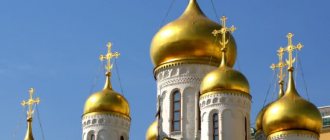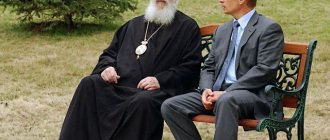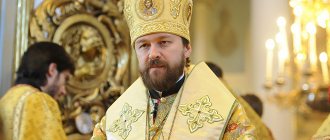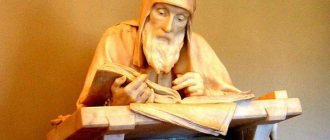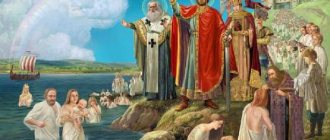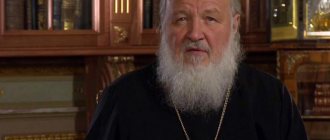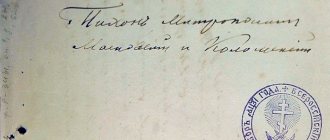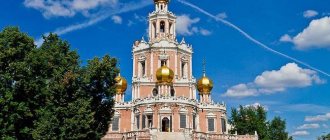Baptism of Rus'
Began in c. The spread of Christianity in Rus' was facilitated by its proximity to a powerful Christian power - the Byzantine Empire. The south of Rus' was sanctified by the activities of the holy Equal-to-the-Apostles brothers Cyril and Methodius, educators of the Slavs. In 954, Princess Olga of Kiev was baptized. All this prepared the greatest events in the history of the Russian people - the baptism of Prince Vladimir and the Baptism of Rus' in 988.
In the pre-Mongol period of its history, the Russian Church was one of the metropolises of the Patriarchate of Constantinople. The metropolitan who headed the Church was appointed by the Greek Patriarch of Constantinople, but in 1051 the Russian Metropolitan Hilarion, the most educated man of his time and a remarkable church writer, was first installed on the high priestly throne.
Majestic temples have been built since centuries. Since the century, monasteries have begun to develop in Rus'. In 1051, the Monk Anthony of Pechersk brought the traditions of Athonite monasticism to Rus', founding the famous Kiev-Pechersk Monastery, which became the center of the religious life of Ancient Rus'. The role of monasteries in Rus' was enormous. And their main service to the Russian people - not to mention their purely spiritual role - is that they were the largest centers of education. In the monasteries, in particular, chronicles were kept that brought to this day information about all significant events in the history of the Russian people. Icon painting and the art of book writing flourished in the monasteries, and translations of theological, historical and literary works into Russian were carried out. The extensive charitable activities of monastic monasteries contributed to the cultivation of the spirit of mercy and compassion among the people.
In the 12th century, during the period of feudal fragmentation, the Russian Church remained the only bearer of the idea of the unity of the Russian people, counteracting the centrifugal aspirations and civil strife of the princes. The Tatar-Mongol invasion - the greatest disaster that befell Rus' in the 13th century - did not break the Russian Church. She remained as a real force and was a comforter to the people in this difficult trial. Spiritually, materially and morally, she contributed to the restoration of the political unity of Rus' - the key to future victory over the enslavers.
The unification of scattered Russian principalities around Moscow began in the 14th century. And the Russian Church continued to play an important role in the revival of a united Rus'. Outstanding Russian saints were the spiritual leaders and assistants of the Moscow princes. Saint Metropolitan Alexy (1354-1378) raised the holy noble prince Demetrius Donskoy. He, like later Metropolitan Jonah of Moscow (1448-1471), by the power of his authority helped the Moscow prince in ending feudal unrest and preserving state unity. The great ascetic of the Russian Church, St. Sergius of Radonezh, blessed Demetrius Donskoy for the greatest feat of arms - the Battle of Kulikovo, which served as the beginning of the liberation of Rus' from the Mongol yoke.
Monasteries greatly contributed to the preservation of the national identity and culture of the Russian people during the difficult years of the Tatar-Mongol yoke and Western influences. The Pochaev Lavra was founded in the 13th century. This monastery and its abbot, Reverend Job, did a lot to establish Orthodoxy in Western Russian lands. In total, from the 14th century to half the century, up to 180 new monastic monasteries were founded in Rus'. The largest event in the history of ancient Russian monasticism was the founding of the Trinity-Sergius Monastery by St. Sergius of Radonezh (around 1334). Here, in this later famous monastery, the wondrous talent of the icon painter St. Andrei Rublev blossomed.
How it all began
Before baptism, Rus' was pagan. All around one could see towering idol temples. The population of Rus' worshiped various pagan gods: Perun, Yaril, etc. Our ancestors believed that prosperity and a good harvest depended on the favor of these gods. Therefore they built their idols and worshiped them.
Some historians argue that Orthodoxy appeared in our country much earlier than the baptism of Russia . Prince Askold, who ruled in Kyiv, tried to instill the Orthodox faith among our ancestors, but he was prevented by convinced pagans, who were the majority in Rus' at that time.
Later, Saint Olga accepted the Orthodox faith, but she, too, was not given the opportunity to convert the country to Orthodoxy. Prince Vladimir, succeeded . According to legend, the prince immediately liked the Greek’s preaching, but he was in no hurry to accept the Orthodox faith. First I listened to adherents of other religions.
The prince's ambassadors liked the Greek service in the temple; they claimed that they were as if they were in heaven. But the prince accepted the Orthodox faith on a political basis. He went to war against Korsun because the emperor did not fulfill the condition of the agreement - to give his sister for Vladimir. In the end, he had to do it, but the Russian prince had to convert to Orthodoxy.
Before receiving the Sacrament of baptism, the prince became blind, as legend tells. But while immersed in the font, he regained his sight. Therefore, he received the title of “second Paul.” Upon returning to his homeland, he decided to convert all the inhabitants of Rus' to the Orthodox faith.
The prince ordered to destroy all the idols, throwing them into the river. Priests from Greece baptized the Russian people. All families hurried to the Dnieper River, where they were baptized. However, not everyone accepted the will of the prince. Some withdrew, not wanting to be baptized. And others ran crying after the idols floating along the river.
The Orthodox faith did not immediately take root in Rus'. It was necessary to replace pagan holidays with Orthodox ones. For example, Yarila turned into Elijah the prophet . And the holiday of Kupala became the Nativity of John the Baptist . Some pagan customs were preserved in church life, for example, decorating a temple with birch trees.
Autocephaly of the Russian Church
| Certificate of the Council of Constantinople on the founding of the Moscow Patriarchate on May 8, 1590. Parchment, ink (in Greek). The letter was signed by 106 people: Patriarchs Jeremiah II of Constantinople, Joachim of Antioch and Sophronius of Jerusalem, as well as 42 metropolitans, 19 archbishops and 20 bishops. |
Freed from the invaders, the Russian state gained strength, and with it the strength of the Russian Orthodox Church grew.
In 1448, shortly before the fall of the Byzantine Empire, the Russian Church became independent of the Patriarchate of Constantinople. Metropolitan Jonah, installed by the Council of Russian Bishops in 1448, received the title of Metropolitan of Moscow and All Rus'. Subsequently, the growing power of the Russian state contributed to the growth of the authority of the Autocephalous Russian Church. In 1589, Moscow Metropolitan Job became the first Russian Patriarch. The Eastern Patriarchs recognized the Russian Patriarch as fifth in honor.
The 17th century started out hard for Russia. Polish-Swedish invaders invaded Russian Land from the west. During this time of unrest, the Russian Church, as before, honorably fulfilled its patriotic duty to the people. The ardent patriot Patriarch Ermogen (1606-1612), tortured by the interventionists, was the spiritual leader of the militia of Minin and Pozharsky. The heroic defense of the Trinity-Sergius Lavra from the Swedes and Poles in 1608-1610 is forever inscribed in the chronicle of the history of the Russian state and the Russian Church.
In the period following the expulsion of the interventionists from Russia, the Russian Church dealt with one of its very important internal problems - the correction of liturgical books and rituals. Much of the credit for this belonged to Patriarch Nikon. At the same time, shortcomings in the preparation of the reform and its forced imposition inflicted a severe wound on the Russian Church, the consequences of which have not been overcome to this day - the split of the Old Believers.
Synodal period
The beginning of the 18th century was marked for Russia by the radical reforms of Peter I. The reform also affected the Russian Church: after the death of Patriarch Adrian in 1700, Peter I delayed the election of a new Primate of the Church, and in 1721 established a collegial higher church government represented by the Holy Governing Synod, which remained the highest church body for almost two hundred years. Members of the Holy Synod were appointed by the emperor, and the Synod was governed by secular government officials - chief prosecutors. The transformation into a state institution and the deprivation of independence had the most detrimental effect on the state of the Russian Church.
During the Synodal period of its history (1721-1917), the Russian Church paid special attention to the development of spiritual education and missionary work on the outskirts of the country.
The 19th century gave great examples of Russian holiness: the outstanding hierarchs, Metropolitans of Moscow Philaret and Innocent, St. Seraphim of Sarov, the elders of the Optina and Glinsk hermitages.
Second "center of power"
Under Tsar Alexei Mikhailovich, Patriarch Nikon bore the title of “Great Sovereign,” and the broad powers of the head of the church ultimately brought him into conflict with the monarch. This struggle ended with the victory of the tsar and the deprivation of Nikon's dignity, but the problem was not completely resolved.
, Peter I was able to appreciate the influence of the patriarch, who pacified the Streltsy riots and, in general, had a huge influence on the struggle in the ranks of the court nobility. In 1689, Patriarch Joachim , siding with Peter, helped him win the fight against Princess Sophia .
But the young king, who started reforms in the Western style, saw that the church hierarchs, including the new Patriarch Hadrian , were not delighted with his innovations. Nevertheless, it was not in the interests of the king to go into open conflict, and Adrian, too, unlike the more radically minded hierarchs, did not strive for a “hot” confrontation.
Although over time the relationship became increasingly tense. Peter's first wife Evdokia Lopukhina as a nun , and he, in turn, ignored the patriarch's request to pardon the participants in the Streltsy riot sentenced to death.
Patriarch Adrian. Parsuna, early 18th century. Photo: Commons.wikimedia.org
Restoration of the Patriarchate. Soviet persecution
At the beginning of the century, preparations began for the convening of the All-Russian Church Council. The Council was convened only after the February Revolution - in 1917. His greatest act was the restoration of the Patriarchal administration of the Russian Church. Metropolitan Tikhon of Moscow was elected at this Council as Patriarch of Moscow and All Rus' (1917-1925).
Saint Tikhon made every effort to calm the destructive passions fanned by the revolution. The Message of the Holy Council dated November 11, 1917 said: “Instead of the new social structure promised by the false teachers, there is a bloody feud among the builders; instead of peace and brotherhood of peoples, there is a confusion of languages and the bitter hatred of brothers. People who have forgotten God rush at each other like hungry wolves... Leave the crazy and wicked dream of false teachers who call for the implementation of world brotherhood through world civil strife! Return to the path of Christ!”
For the Bolsheviks, who came to power in 1917, the Russian Orthodox Church was a priori an ideological enemy. That is why many bishops, thousands of priests, monks, nuns and laity were subjected to repression, including execution and murders that were shocking in their cruelty.
When in 1921 the Soviet government demanded the release of valuable sacred objects, things came to a fatal conflict between the Church and the new government, which decided to use the situation for the complete and final destruction of the Church.
In May 1922, Patriarch Tikhon (Belavin) was arrested and the so-called the “renovationist schism,” which declared complete solidarity with the goals of the revolution. A significant part of the clergy went into schism, but he did not receive mass support among the people. In June 1924, the Patriarch was released and the renovationist movement began to decline.
Even before his arrest, Patriarch Tikhon subordinated all foreign Russian parishes to Metropolitan Eulogius (Georgievsky) and declared the decisions of the so-called invalid. “Karlovak Cathedral”, which created its own Church Administration. The non-recognition of this Patriarchal Decree marked the beginning of the independent “Russian Orthodox Church Abroad” (ROCOR).
After the death of Patriarch Tikhon, a complex, power-directed struggle for the hierarchical leadership of the Church unfolded. Ultimately, Metropolitan Sergius (Stragorodsky) became the head of the church administration. The obligations to the authorities that he was forced to accept at the same time caused a protest from some of the clergy and people, who went to the so-called. “right-wing schism” and created the “Catacomb Church”.
By the outbreak of World War II, the church structure throughout the country was almost completely eliminated. There were only a few bishops left free who could perform their duties. In the entire Soviet Union, only a few hundred churches were open for worship. Most of the clergy were in camps, where many were killed or disappeared.
The catastrophic course of hostilities for the country at the beginning of World War II forced Stalin to mobilize all national reserves for defense, including the Russian Orthodox Church as a popular moral force. Temples opened for worship. The clergy, including bishops, were released from the camps. The Russian Church did not limit itself only to spiritual support for the cause of defending the Fatherland in danger - it also provided material assistance, including uniforms for the army, financing the tank column named after Dmitry Donskoy and the squadron named after Alexander Nevsky.
The culmination of this process, which can be characterized as the rapprochement of the state and the Church in “patriotic unity,” was Stalin’s reception on September 4, 1943 of the Patriarchal Locum Tenens Metropolitan Sergius (Stragorodsky) and Metropolitans Alexy (Simansky) and Nikolai (Yarushevich).
At the Council of Bishops in 1943, Met. Sergius was elected Patriarch, and at the Local Council in 1945, Metropolitan Alexy. After this, most of the so-called "Catacomb Church" at the call of Bishop. Afanasia (Sakharova), whom many catacombs considered their spiritual leader, reunited with the Moscow Patriarchate.
From this historical moment, a short period of “thaw” began in relations between the Church and the state, but the Church was constantly under state control, and any attempts to expand its activities outside the walls of the temple were met with unyielding resistance, including administrative sanctions.
In 1948, a large-scale Pan-Orthodox conference was convened in Moscow, after which the Russian Church was involved in active participation in the international movement “struggle for peace and disarmament” launched on Stalin’s initiative.
The position of the Russian Orthodox Church became difficult at the end of the so-called “Khrushchev Thaw”, when thousands of churches throughout the Soviet Union were closed for the sake of ideological principles. During the “Brezhnev” period, the active persecution of the Church stopped, but there was also no improvement in relations with the state. The church remained under strict government control and believers were treated as “second-class citizens.”
Propagation of the Orthodox faith in Rus'
The first saints of newly enlightened Rus' were the passion-bearers brothers Boris and Gleb. They suffered martyrdom at the hands of their brother, who was striving for power.
The Kiev throne passed to Vladimir's son, Yaroslav. He set out to continue his father’s work - to strengthen the Orthodox faith in Rus'. He strengthened contact with powers that had rich experience in this faith.
Yaroslav distributed relevant literature and introduced Orthodox customs. For the purpose of teaching, he received Christian ambassadors from different countries.
In order for people to be able to read Orthodox books, the prince ordered to improve literacy education everywhere. Ordinary people were also able to get this opportunity. He created a people's Orthodox library and Sunday schools in different places in Rus'.
Yaroslav's son Svyatoslav vowed to continue his father's work. Church metropolises began to be created. Dioceses appeared in large cities of Rus'. Although at first, for a whole century, Rus' was under the leadership of Greek metropolitans. And at the beginning of the eleventh century, the prince made Hilarion, a thinker, philosopher and writer, the first Russian metropolitan.
At that time, there was an increase in scientists, writers, and icon painters. The first chronicles appeared, the most famous author of such a book was the monk Nestor. Byzantine masters built temples in Rus' and painted them. Yaroslav ordered to build a temple in Kiev in honor of St. Sophia .
Modern history
The celebration of the Millennium of the Baptism of Rus' in 1988 marked the decline of the state-atheist system, gave a positive impetus to church-state relations, forced those in power to begin a dialogue with the Church and build relationships with it on the principles of recognition of its enormous historical role in the fate of the Fatherland and its contribution to the formation of moral foundations of the nation.
However, the consequences of the persecution turned out to be very, very serious. It was necessary not only to restore thousands of churches and hundreds of monasteries from ruins, but also to revive the traditions of educational, educational, charitable, missionary, church and public service.
Metropolitan Alexy of Leningrad and Novgorod, who was elected by the Local Council of the Russian Orthodox Church to the First Hierarchal See, widowed after the death of His Holiness Patriarch Pimen, was destined to lead the church revival in these difficult conditions. On June 10, 1990, the enthronement of His Holiness Patriarch of Moscow and All Rus' Alexy II took place.
